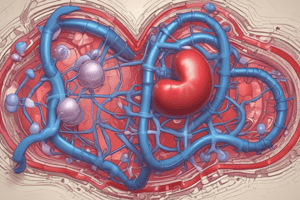Podcast
Questions and Answers
What is the significance of a steady-state serum digoxin level of 0.5 ng/mL for BH?
What is the significance of a steady-state serum digoxin level of 0.5 ng/mL for BH?
- It confirms an appropriate therapeutic level for BH currently. (correct)
- It shows digoxin is below the therapeutic range for heart failure.
- It means the dose of digoxin is too high and should be decreased.
- It indicates digoxin is not being absorbed.
What could be a reason for BH's physician to want to increase the digoxin dose?
What could be a reason for BH's physician to want to increase the digoxin dose?
- To achieve a higher therapeutic effect. (correct)
- To improve renal function.
- To prevent digoxin toxicity.
- To reduce the side effects of the drug.
What initial dosing strategy would the physician likely choose for digoxin considering its half-life?
What initial dosing strategy would the physician likely choose for digoxin considering its half-life?
- Dosing every other day.
- Dosing once daily. (correct)
- Dosing twice daily.
- Dosing weekly.
What is the main concern when adjusting the digoxin dose for a patient like BH?
What is the main concern when adjusting the digoxin dose for a patient like BH?
How is digoxin primarily eliminated from the body?
How is digoxin primarily eliminated from the body?
What is the primary use of Digoxin?
What is the primary use of Digoxin?
What is the typical bioavailability of Digoxin tablets?
What is the typical bioavailability of Digoxin tablets?
What is the range of Digoxin distribution in the body?
What is the range of Digoxin distribution in the body?
What are the recommended loading doses for Digoxin?
What are the recommended loading doses for Digoxin?
What is a major adverse event associated with Digoxin use?
What is a major adverse event associated with Digoxin use?
Which statement is true regarding Digoxin absorption?
Which statement is true regarding Digoxin absorption?
How should Digoxin dosage be based in practice?
How should Digoxin dosage be based in practice?
What characteristic of Digoxin's pharmacokinetics is highlighted in its usage?
What characteristic of Digoxin's pharmacokinetics is highlighted in its usage?
What is the main route of elimination for digoxin?
What is the main route of elimination for digoxin?
What parameter is used to calculate the metabolic clearance (CLm) for patients with moderate to severe heart failure?
What parameter is used to calculate the metabolic clearance (CLm) for patients with moderate to severe heart failure?
What is the half-life (t1/2) of digoxin?
What is the half-life (t1/2) of digoxin?
How is the clearance (CL) of digoxin affected in patients with mild heart failure (HF)?
How is the clearance (CL) of digoxin affected in patients with mild heart failure (HF)?
What is the formula for determining the maintenance dose (MD) of digoxin?
What is the formula for determining the maintenance dose (MD) of digoxin?
What target steady-state plasma concentration (Css) is typically used for patients with heart failure?
What target steady-state plasma concentration (Css) is typically used for patients with heart failure?
Which formula allows for the calculation of the desired concentration of digoxin at a specific time?
Which formula allows for the calculation of the desired concentration of digoxin at a specific time?
What is the dosing interval (t) in minutes when calculating the maintenance dose for digoxin over one day?
What is the dosing interval (t) in minutes when calculating the maintenance dose for digoxin over one day?
Flashcards are hidden until you start studying
Study Notes
Digoxin: Indications, MOA, & Loading Doses
- Class and MOA: Digoxin is a cardiac glycoside that acts as a sodium-potassium ATPase inhibitor. It increases myocardial contractility and decreases heart rate.
- Indications: Primarily used for heart failure and atrial fibrillation, but also used for supraventricular arrhythmias.
- Loading Doses: While loading doses were previously common, current practice favors alternative therapies due to the potential for toxicity.
Digoxin: Adverse Events
- Main Adverse Event: Cardiac arrhythmias due to digoxin toxicity.
- Visual Symptoms: The most common symptom is seeing a yellow-green halo.
### Digoxin: Pharmacokinetics
- Absorption: Bioavailability varies between oral dosage forms, tablets are ~70% and elixir is ~80%.
- Distribution: Ranges from 4 to 9 L/kg, with an average value of 7 L/kg used in practice. Always use ideal body weight (IBW) for calculations.
- Metabolism: Primarily metabolized by the liver, with minimal bacterial metabolism in the large intestine.
- Elimination: Renally excreted, with approximately 70% being eliminated unchanged. The half-life is around 2 days.
Digoxin: Pharmacokinetic Calculations
- Population-Based Clearance: Calculated using the following equation: CL = (1.303 x CrCl*) + CLm.
- CLm (metabolic clearance) is 40 mL/min for patients with no or mild heart failure and 20 mL/min for patients with moderate to severe heart failure.
- Patient-Specific Clearance: Calculated using the following equation: CL = MD x 106 x F / Css x !
- MD: Maintenance dose in mg/day
- F: Bioavailability
- Css: Steady-state plasma concentration in ng/mL
- !: Dosing interval in minutes (1440 minutes = 1 day)
Digoxin: Dosing Calculations
- Calculation #1 - Maintenance Dose: MD = Css x CL x ! / 106 x F
- Css: Steady-state plasma concentration in ng/mL
- Goal for heart failure: 0.5 - 0.9 ng/mL
- Goal for atrial fibrillation: 1 - 2 ng/mL
- !: Dosing interval in minutes (1440 minutes = 1 day)
- Calculation #2 - Time to Desired Level: CDESIRED= Css x e-kt
- t: Time required to reach the desired level
### Digoxin: Practice Problems
- Practical Considerations:
- Given the long half-life of digoxin, it is typically administered once daily.
- Once a steady-state serum digoxin level is achieved, it can be used to calculate the patient's real clearance.
- This allows for adjustments in the maintenance dose to achieve a desired serum concentration.
Studying That Suits You
Use AI to generate personalized quizzes and flashcards to suit your learning preferences.




